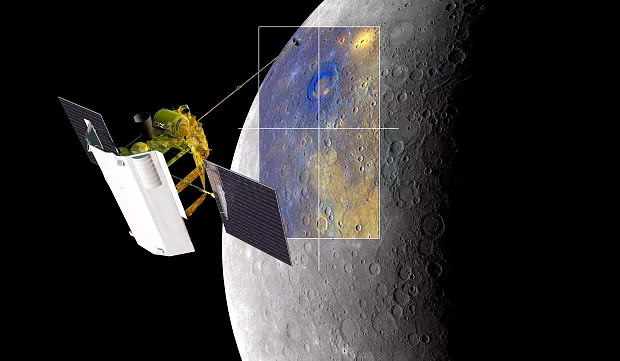Evidence that Mercury is not a dead planet
Mercury is the solar system's innermost planet, it is a giant stone sphere with an ugly arid surface. However, with the recent findings of scientists, it is not a dead planet, but is working silently under the ground.
Scientists based on data collected from NASA's MESSENGER spacecraft have discovered Mercury also contains frozen water with organic matter inside . These findings make it a very active living planet.

NASA's MESSENGER probe ship simulation is investigating Mercury.(Photo: NASA).
1. Great valley
NASA's MESSENGER probe finds a valley on Mercury , which is bigger than the Grand Canyon deep gorge on Earth. It was probably formed when Mercury's lithosphere began to harden and cool 3 or 4 billion years ago.
With a width of 400 km and a length of 965 km, which is twice as deep as the Grand Canyon, if placed on Earth, it would stretch the same distance from Washington DC to New York City and reach farther. Detroit, Michigan.

The vast valleys of Mercury.(Photo: NASA).
When this valley was discovered, it posed challenges for scientists. This valley contradicts the previous hypothesis, arguing that Mercury only works for a while after it is formed. There are also some areas on Mercury that seem to have volcanoes, which must have geological activity on this planet.
"Everyone thinks Mercury is a very cold planet. But actually Mercury is gradually becoming warmer during the later period of planet formation , " said study co-author Laurent Montesi. a vice professor of geology at the University of Maryland, said in a statement.
2. Volcanic basin
The Caloris Basin is one of the most impacted places ever known in the Solar System. It was discovered in 1974 when the Mariner 10 flew through Mercury, but only half of the basin was illuminated at that time.
When the MESSENGER vessel flew over Mercury for the first time, it was able to observe the entire basin and observation data suggested that it had a long history of volcanoes.

The large Caloris volcanic basin with evidence is believed to have had lava eruptions here.(Photo: NASA).
Looking more specifically at the basin, scientists have found evidence that lava flows from the center of the basin when there is an area of about 1500 km surrounding the center. Lava covered a layer of up to 3.5 km thick.
3. There are geological activities
In a year and a half of operation, the MESSENGER has been flying low and can see Mercury's surface in great detail. One of the things he saw was the small cliffs that were very young because many craters on them were not faded by time.

When discovering young cliffs discovered on Mercury, scientists questioned the need for geological activity to create them.(Photo: NASA).
"Young cliffs mean that Mercury as well as Earth are very active planets, for a number of reasons why Mercury becomes deeper and reduces signs of activity like Earth." The study's lead author, Tom Watters from the National Air and Space Museum, said in a statement.
4. Freezing water
With great support by radar observers from Earth, the ship MESSENGER claims to be capable of existing frozen water on Mercury's pole. This is concluded from three different theories: the abundance of hydrogen gas is measured by the ship MESSENGER itself, the reflection of radio signals when the polar probe, other extreme thermal models different from other regions on Mercury.
 Polar regions of Mercury may exist in frozen water.(Photo: NASA).
Polar regions of Mercury may exist in frozen water.(Photo: NASA).
" Based on observation and survey data, there is a layer of tens of centimeters of hydrogen beneath a layer of surficial 10 to 20 cm thick and less hydrogen. There is also a low layer of hydrogen at the surface. The face can form pure water in frozen form , " said David Lawrance, a scientist at Hopkins Applied Physics Laboratory.
5. Organic compound
Scientists noticed something when surveying the ice on Mercury. Although the water froze in the cold, they still found the warmth radiating from them. Scientists believe that these mysterious materials contain organic compounds from meteorites or comets when they collide with Mercury.
 There may be organic compounds on Mercury, they come from distant meteorites in the Solar System.(Photo: NASA).
There may be organic compounds on Mercury, they come from distant meteorites in the Solar System.(Photo: NASA).
Organic compounds are considered to be one of the core bricks to build life, but they are not the only factor to create life. Organic compounds have been found on Saturn's Mars, Mars and Saturn planets.
The organic compounds discovered so far are all liquids that have a prebiotic chemical reaction, which means they become a precursor to creating life-sustaining and life-sustaining reactions. this.
- Mercury is not a dead planet
- The 'dead planet' used to be a giant fire cauldron
- Add evidence of volcanoes operating on Mercury
- Photos never published about Mercury
- Mysterious planet of the solar system
- Things you may not know about Mercury
- Mercury inversely causes society to be confused? Science says it's okay
- Overview of Mercury
- Mercury shrinks faster than expected
- Decode the mystery of Mercury's personality
- Uncover the mysteries of Mercury
- Mercury '1 day' by 2 years
 Van Allen's belt and evidence that the Apollo 11 mission to the Moon was myth
Van Allen's belt and evidence that the Apollo 11 mission to the Moon was myth The levels of civilization in the universe (Kardashev scale)
The levels of civilization in the universe (Kardashev scale) Today Mars, the sun and the Earth are aligned
Today Mars, the sun and the Earth are aligned The Amazon owner announced a secret plan to build a space base for thousands of people
The Amazon owner announced a secret plan to build a space base for thousands of people